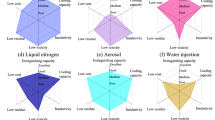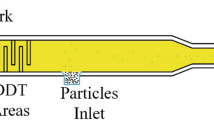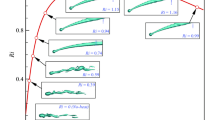Abstract
The ignition and reaction mechanisms of the thermal explosion reaction in the Ni-Ti-C system under air and Ar conditions were investigated. The reaction for the formation of TiC can be initiated at a low temperature under air. The ignition temperature under air is much lower than that under Ar. Under Ar, both the ignition and reaction mechanisms consist of dissolution, reaction, and precipitation. Under air, the ignition mechanism is confirmed to be the chemical oven mechanism, and the reaction mechanism is dissolution, reaction, and precipitation. The mechanism of gas transport plays a much more minor role in the ignition and reaction processes under air.
Similar content being viewed by others
References
G.Q. Xiao, Q.C. Fan, M.Z. Gu, Z.H. Wang, and Z.H. Jin: Dissolution-precipation mechanism of self-propagating hightemperature synthesis of TiC-Ni cermet. Mater. Sci. Eng., A 382, 132 (2004).
J.J. Moore and H.J. Feng: Combustion synthesis of advanced materials: Part I. Reaction parameters. Prog. Mater. Sci. 39, 243 (1995).
H.C. Yi and J.J. Moore: Self-propagating high-temperature synthesis (SHS) of powder-compacted materials. J. Mater. Sci. 25, 1159 (1990).
I. Song, L. Wang, M. Wixom, and L.T. Thompson: Selfpropagating high temperature synthesis and dynamic compaction of titanium diboride/titanium carbide composites. J. Mater. Sci. 35, 2611 (2000).
N. Durlu: Titanium carbide based composites for high temperature applications. J. Eur. Ceram. Soc. 19, 2415 (1999).
S.D. Dunmead, D.W. Ready, C.E. Semler, and J.B. Holt: Kinetics of combustion synthesis in the Ti-C and Ti-C-Ni systems. J. Am. Ceram. Soc. 72, 2318 (1989).
J.C. LaSalvia, D.K. Kim, R.A. Lipsett, and M.A. Meyers: Combustion synthesis in the Ti-C-Ni-Mo system. Part I. Micromechanisms. Metall. Mater. Trans. A 26, 3001 (1995).
J.C. LaSalvia and M.A. Meyers: Combustion synthesis in the Ti-C-Ni-Mo system: Part II. Analysis. Metall. Mater. Trans. A 26, 3011 (1995).
S.K. Mishra, S.K. Das, A.K. Ray, and P. Ramchandrarao: Effect of nickel on sintering of self-propagating high-temperature synthesis produced titanium carbide. J. Mater. Res. 14, 3594 (1999).
J. Wong, E.M. Larson, J.B. Holt, P.A. Waide, B. Rupp, and R. Frahm: Time-resolved x-ray diffraction study of solid combustion reactions. Science 249, 1406 (1990).
Q.C. Fan, H.F. Chai, and Z.H. Jin: Role of iron addition in combustion synthesis of TiC-Fe cermet. J. Mater. Sci. 32, 4319 (1997).
I.J. Shon and Z.A. Munir: Synthesis of TiC, TiC-Cu composites, and TiC-Cu functionally graded materials by electrothermal combustion. J. Am. Ceram. Soc. 81, 3243 (1998).
L. Klinger, I. Gotman, and D. Horvitz: In situ processing of TiB2/TiC ceramic composites by thermal explosion under pressure: Experimental study and modeling. Mater. Sci. Eng., A 302, 92 (2001).
D. Atong and D.E. Clark: Ignition behavior and characteristics of microwave-combustion synthesized Al2O3–TiC powders. Ceram. Int. 30, 1909 (2004).
J.H. Lee, S.K. Ko, and C.W. Won: Combustion characteristics of TiO2/Al/C system. Mater. Res. Bull. 36, 1157 (2001).
Y. Choi and S.W. Rhee: Reaction of TiO2-Al-C in the combustion synthesis of TiC-Al2O3 composite. J. Am. Ceram. Soc. 78, 986 (1995).
R. Koc: Kinetic and phase evolution during carbothermal synthesis of titanium carbide from ultrafine titania/carbon mixture. J. Mater. Sci. 33, 1049 (1998).
M. Eslamloo-Grami and Z.A. Munir: Effect of porosity on the combustion synthesis of titanium nitride. J. Am. Ceram. Soc. 73, 1235 (1990).
M. Eslamloo-Grami and Z.A. Munir: Effect of nitrogen pressure and diluent content on the combustion synthesis of titanium nitride. J. Am. Ceram. Soc. 73, 2222 (1990).
C.C. Agrafiotis, J.A. Puszynski, and V. Hlavacek: Experimental study on the synthesis of titanium and tantalum nitrides in the self-propagating regime. Combust. Sci. Technol. 76, 187 (1991).
A.G. Merzhanov and I.P. Borovinskaya: Self-propagating hightemperature sysnthesis of inoganic compounds. Dokl. Akad. Nauk 204, 429 (1972).
C.L. Yeh and H.C. Chuang: Experimental studies on selfpropagating combustion synthesis of niobium nitride. Ceram. Int. 30, 733 (2004).
C.L. Yeh, E.W. Liu, and Y.C. Chang: Effect of preheating on synthesis of tantalum nitride by self-propagating combustion. J. Eur. Ceram. Soc. 24, 3807 (2004).
Y.J. Liang and Y.C. Che: Handbook of Thermodynamic Data of Inorganics (Northeastern University Press, Shenyang, 1993).
I. Barin: Thermochemical Data of Pure Substances, 2nd ed. (VCH GmbH, Weinheim, Germany, 1993).
Y.F. Yang, H.Y. Wang, Y.H. Liang, R.Y. Zhao, and Q.C. Jiang: Effects of C particle size on the ignition and combustion characteristics of the SHS reaction in the 20wt%Ni-Ti-C system. J. Alloys Compd. 460, 276 (2008).
M. Kakazey, M. Vlasova, J.G. Gonzalez-Rodriguez, M. Dominguez-Patino, and R. Leder: X-ray and EPR study of reactions between B4C and TiO2. Mater. Sci. Eng., A 418, 111 (2006).
S. Adachi, T. Wada, T. Mihara, Y. Miyamoto, M. Koizumi, and O. Yamada: Fabrication of titanium carbide ceramics by highpressure self-combustion sintering of titanium powder and carbon fiber. J. Am. Ceram. Soc. 72, 805 (1989).
J.G. Xu, B.L. Zhang, and G.J. Jiang: Synthesis of SiCw/MoSi2 powder by the “chemical oven” self-propagating combustion method. Ceram. Int. 32, 633 (2006).
T.B. Massalski, H. Okamoto, P.R. Subramanian, and L. Kacprzak: Binary Alloy Phase Diagrams, 2nd ed. (ASM International, Materials Park, OH, 1990).
J.B. Holt and Z.A. Munir: Combution synthesis of titanium carbide: Theory and experiment. J. Mater. Sci. 21, 251 (1986).
Author information
Authors and Affiliations
Corresponding author
Rights and permissions
About this article
Cite this article
Yang, YF., Wang, HY., Wang, JG. et al. Ignition and reaction mechanisms of thermal explosion reaction in the Ni-Ti-C system under air and Ar. Journal of Materials Research 24, 3197–3205 (2009). https://doi.org/10.1557/jmr.2009.0370
Received:
Accepted:
Published:
Issue Date:
DOI: https://doi.org/10.1557/jmr.2009.0370




